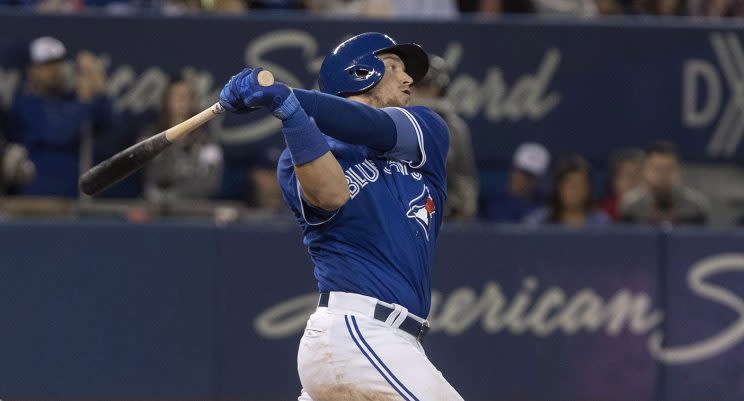Justin Smoak uses new approach to play hero for Blue Jays
Last season when Justin Smoak strode to the plate Toronto Blue Jays fans felt like they knew what to expect. Smoak was a classic ‘Three True Outcomes‘ guy as 48.9 percent of his trips to the dish resulted in a strikeout, walk or home run.
That’s a perfectly fine way to create your offence, but unfortunately for the Blue Jays, the strikeouts were too plentiful and the home runs were too scarce. For what it’s worth, the walks were about right.
This season the story has been a little different, and Smoak showed just how going 3-for-3 with four RBI in the Blue Jays’ 7-2 win over the Seattle Mariners on Thursday night.
“He’s a little bit more aggressive early in the count,” manager John Gibbons said of his current cleanup hitter. “And he’s laying off that bad breaking ball that borderline one, or the one on the ground — the tough one.”
In Smoak’s first at-bat, the big first baseman came up with two runners on and one out and ripped a middle-in fastball from Chase De Jong into centre field to put Toronto on the board.
Four innings later, Smoak found himself in another big spot with the bases loaded and two outs. He got a first-pitch curveball away and dumped it just over the outstretched glove of shifted shortstop Jean Segura to plate two and bring the score to 3-2. Although Steve Pearce followed with a three-run insurance blast, that pair was all the Blue Jays needed.
To cap off his night, in the seventh, Smoak even put his power-hitter hat back on with an 409-foot bomb to centre off Sam Gaviglio.
“I think it’s just [about] consistency,” the switch hitter said of his success. “Being in there more and really knowing you’re going to be in there when you show up to the park everyday.”

The three-hit day was a pretty significant rarity for Smoak, who’s earned a reputation as an all-or-nothing type in the past. Last season, the slugger appeared in 126 games and managed the feat twice. Thursday’s performance was indicative of a season-long trend for Smoak where he’s made a concerted effort to prioritize contact.
“I feel like I’ve been doing a better job of that,” Smoak told Mark Zwolinski of the Toronto Star in April. “Last year, when there wasn’t a lot of playing time, I tried to hit everything — all three or four pitches the pitchers had — and you can’t do that. Now, you’re up there more often and you hit what you’re given, and with two strikes you just battle your butt off.”
Smoak’s efforts in this area are certainly bearing fruit. He brought an 80.7 percent contact rate into the game, better than the league average of 77.6 percent. Last year, his mark was a significantly below-average 72 percent. He’s been especially good at connecting on pitches in the zone — his 95.5 percent rate there ranked fourth out of 184 qualified hitters coming into Thursday.
Consequently, the former 11th overall pick has seen his strikeout rate shrivel. Last year pitchers were punching him out 32.8 percent of the time — this year that number sits at 21.5 percent. The result of all of these improvements is a .274/.314/.494 line that looks plenty respectable in the middle of a lineup that could certainly use a little reliability.
At this point, it’s hard to know exactly how well Smoak will sustain the adjustments he’s made so far. It’s possible that come August he’s swinging at as much air as he ever did. However, for now he’s demonstrating a change in philosophy and the results are following.
The plan of attack is different — and on Thursday night it looked pretty damn effective.

 Yahoo Sports
Yahoo Sports 


